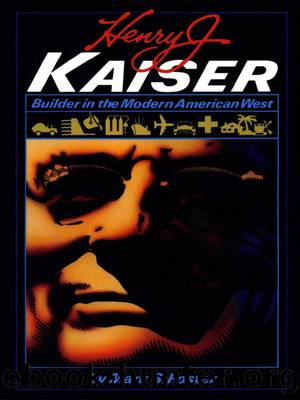Henry J. Kaiser: Builder in the Modern American West by Mark S. Foster

Author:Mark S. Foster
Language: eng
Format: epub
Tags: -
Publisher: University of Texas Press
Published: 2014-08-09T00:00:00+00:00
11
Cargo Planes and Government Investigations
When Henry Kaiserâs name is mentioned today, many are aware of his contributions to health care. When asked to list his enterprises, most cite aluminum and steel; those with a sense of history might add dams, shipbuilding, and automobiles. When informed that Kaiser was active in the aircraft industry for more than a decade, most are surprised. Although Kaiser explored numerous options in private aviation, most of his work was in defense contracts for the government. In 1942 he proposed a fleet of five thousand cargo planes. The plan gained considerable publicity, but little government support; aviation decisionmakers threw Kaiser a sop in the form of a contract to build three prototype giant cargo planes, including the famous âSpruce Goose.â Until 1953, when the Air Force canceled his contract to build C-119 and C-123 cargo planes, Kaiser was active in the industry.
On November 2, 1947, the enigmatic Howard Hughes piloted the elephantine âSpruce Gooseâ a few feet out of the water in Long Beach, California. The firstâand onlyâflight of the wooden airplane slightly exceeded in length the first successful effort by the Wright brothers, and immediate acclaim for the pilot vastly surpassed that enjoyed by the modest inventors from Dayton, Ohio. Over twenty thousand curious observers witnessed Hughesâ feat. The flight provided the aviator little more than grim satisfaction, however. From the inception of the project in 1942, observers within and outside the aircraft industry had raised a crescendo of criticism, culminating in a highly publicized congressional investigation late in the summer of 1947. For Hughes, the whole experience was expensive, time-consuming, and exasperating. He probably wished he had never met the man who initiated the project, Henry J. Kaiser.1
Early in World War II, however, the project seemed urgent. The shock of Pearl Harbor had worn off, and the nation was grimly arming for war. The spring and early summer of 1942 marked the nadir of the Alliesâ fortunes; their forces were retreating almost everywhere, and defeats piled up. The carnage wrought by German Admiral Erich Raederâs submarines against Allied shipping neared its peak. In the first eleven months after Pearl Harbor they sank over eight million tons of Allied vessels.2
By July 1942 shipbuilding had already made Kaiser a national hero. When he expressed opinions in publicâabout any issueâthe press paid attention. Kaiser concluded that if submarines found cargo ships easy targets, it made sense to avoid them. On Sunday, July 19, 1942, he unveiled a provocative plan: he proposed that millions of tons of cargo be transported by air and claimed that he could produce a fleet of 5,000 seventy-ton cargo planes by the end of 1943.3
The concept was not original, having been offered as early as 1937 by Joseph P. Kennedy, who was then U.S. Maritime Commission chief. His idea was endorsed by aeronautical experts, including Major Alexander P. de Seversky, Grover Loening, and Francis H. Hoge, Jr. By July 1942 the Glenn L. Martin Company was producing the Mars, a seventy-ton cargo plane
Download
This site does not store any files on its server. We only index and link to content provided by other sites. Please contact the content providers to delete copyright contents if any and email us, we'll remove relevant links or contents immediately.
Hit Refresh by Satya Nadella(8851)
When Breath Becomes Air by Paul Kalanithi(8037)
The Girl Without a Voice by Casey Watson(7599)
A Court of Wings and Ruin by Sarah J. Maas(7249)
Do No Harm Stories of Life, Death and Brain Surgery by Henry Marsh(6683)
Shoe Dog by Phil Knight(4884)
Hunger by Roxane Gay(4676)
A Higher Loyalty: Truth, Lies, and Leadership by James Comey(4546)
The Rules Do Not Apply by Ariel Levy(4521)
Everything Happens for a Reason by Kate Bowler(4474)
Tuesdays with Morrie by Mitch Albom(4392)
The Immortal Life of Henrietta Lacks by Rebecca Skloot(4248)
How to Change Your Mind by Michael Pollan(4112)
Millionaire: The Philanderer, Gambler, and Duelist Who Invented Modern Finance by Janet Gleeson(4089)
All Creatures Great and Small by James Herriot(3980)
Tokyo Vice: An American Reporter on the Police Beat in Japan by Jake Adelstein(3860)
Elon Musk by Ashlee Vance(3852)
Man and His Symbols by Carl Gustav Jung(3844)
The Money Culture by Michael Lewis(3843)
